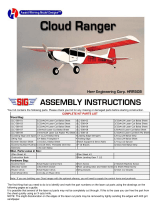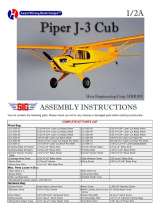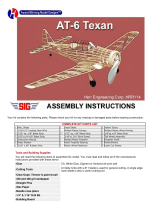Page is loading ...

Your kit contains the following parts. Please check your kit for any missing or damaged parts before starting construction.
COMPLETE KIT PARTS LIST
Wood Bag:
1
LC-503-01
3/32"x4"x24" Laser Cut Balsa Sheet 1
LC-503-02
3/32"x4"x24" Laser Cut Balsa Sheet
1
LC-503-03
3/32"x4"x24" Laser Cut Balsa Sheet 1
LC-503-04
3/32"x4"x24" Laser Cut Balsa Sheet
1
LC-503-05
3/32"x3"x12" Laser Cut Balsa Sheet 1
LC-503-06
3/32"x3"x12" Laser Cut Balsa Sheet
1
LC-503-07
3/32"x3"x12" Laser Cut Balsa Sheet 1
LC-503-08
3mmx4"x24" Laser Cut Poplar Ply
1
LC-503-09
1/16"x3"x4 1/2" Laser Cut Birch Ply 6 Leading Edge and Spars 1/4" sq.x24" Balsa Strip
4 Leading Edge Stringers 3/32" sq.x24" Balsa Strip 1 Wing Tips 3/4" Balsa Trianglex13"
4 Trailing Edge 1/16"x1"x24" Balsa Sheet 2 Center Section Sheet 1/16"x3"x12" Balsa Sheet
1 Hatch Support & Servo
Rails
1/4" sq.x12" Spruce 2 Control Surface Pushrod 1/16"x18" Wire, Threaded One End
2 Throttle and Nose Gear
Pushrod
1/16"x10" Wire, Threaded One End
Misc. Parts Loose in Box
1 Plan Sheet #1 1 Plan Sheet #2
1 Decal Sheet 1 Instruction Book
2 Main Landing Gear
Hardware Bag
2 Control Horn Small Nylon Control Horn 4 Horn Screw 2-56x3/8" Machine Screw
1 Elevator Joiner 1/8"x3" Birch Dowel 5 Main Landing Gear and
Hatch Screw
#2 Sheet Metal Screw
4 Nylon Clevis Small Nylon Clevis 2 Wing Dowels 3/16"x3 1/2" Dowels
Nose Landing Gear Bag
1 Nose Gear Wire 3/32" Pre-Bent Wire 1 Nose Gear Bearing Molded Nylon Bearing Block
1 Steering Collar 3/32" Collar 1 Steering Arm 2-56x1/2" Threaded Stud
1 Steering Arm Fitting Molded Nylon Fitting 4 Mounting Screws 2-56x3/8" Machine Screws
4 Mounting Nuts 2-56 Nuts

.
The first thing that you need to do is to identify and mark the part numbers on the laser cut parts using the drawings on the
following pages as a guide.
It is possible that several of the laser cut parts may not be completely cut through. If this is the case you can free the part from
the sheet quickly using an X-acto knife.
NOTE: The slight discoloration on the edges of the laser cut parts may be removed by lightly sanding the edges with 400 grit
sandpaper.

.
Additional Items Required ( Not Included in Kit)
Note: These are parts that we have used and are familiar with. There are many other brands available and you may
substitute other items that you are more comfortable with or have on hand.
1 Engine Norvel Big Mig .049 or Norvel Big Mig .061
3 Hinges Sig Easy Hinges #SH-710 or Du-Bro Kwik Hinge #537
1 Motor Mount Dave Brown #0506
4 Motor Mount Screws and Blind Nuts 4-40x3/4" Machine Screws and Blind Nuts Sig #SH-III or Du-Bro #129
1 Fuel Tank Sullivan loz. #SS-I or 20z. #SS-2
1 1/2-A Fuel Line Sig #SH288 or Du-Bro #221
4 Servo Connectors Sig #SH-736 or Du-Bro #121
1 White Covering Material 1 Roll Top Flite Monokote, Jet White #TOPQ0204
1 Trim Covering Material Your choice
1 Propeller Grish Tornado 6-3 Nylon Propeller #GRlQI050
8 Rubber Bands (wing attach) Sig #SH-340
3 3/32" Wheel Collars Sig #SH-585 or Du-Bro #138
2 Main Wheels Dave Brown Lectra Lite Wheels #5620
1 Nose Wheel Dave Brown Lectra Lite Wheel #5617
3 Wheel Bushings Make from K&S Brass Tube #127
General Note: Cover the plans with wax paper before assembling your model to prevent the parts from sticking to the plan.
Building the Tail Surfaces
1.
Join R
-
I and R
-
2 together over the plan.
Temporarily hinge the rudder (R
-
3) to the fin. Do not glue the hinges at this time.
2.
Join the elevators using the 1/8" dowel. Use the plan and the stabilizer as a guide. Trim the dowel as required to achieve the
proper length.
3.
Temporarily hinge the elevators to the stabilizer. Do not glue the hinges at this time.
4.
Sand the tail surfaces smooth and round all of the edges except the bottom edge of the fin.
Building the Fuselage
5.
Assemble the left fuselage side (F
-1). Glue parts F-1A (L), F-1B (L) and F-1C (L) together as shown on the plan. The letter
"L" is on the inside of the left fuselage side parts and should face up on all the parts. When the glue is dry, glue part F-2 (L)
into position on the inside of the left fuselage side. Crack part F-3 (L) at the dashed line cut into it at the rear of the part and
glue it into position on the inside of the left fuselage side.
6.
Build the right fuselage side as you did the left. The parts for the right fuselage side are marked with an "R" on the inside of
each piece.

.
7.
Place the right fuselage side on the building board and place formers F-6 and F-
7 into position. These formers should be 90
degrees to the fuselage side. Glue the formers to the fuselage side.
8.
Glue the left fuselage side into position on the formers. The formers should also be 90 degrees to this fuselage side.
9.
Glue the main landing gear support F-6 into position with the markings "TF" at the front and facing the inside of the
fuselage. Glue former F
-
5 into position.
10.
Glue parts F
-
9A to part F
-
9 as shown on the plan.
11.
Gently squeeze the aft end of the fuselage sides together and hold with two clothes pins. Place the formers F-9 and F-10
into position and glue them to the fuselage sides. Glue the aft end of the fuselage sides together making sure that the joint
is straight and not leaning to the left or right.
12.
Place part F-11 into position and glue it to the center of formers F-7, F-9 and F-
10. Working from the front to the rear, gently
pinch the fuselage sides into contact with F
-
11 and glue together.
13.
Place part F
-
12 into position and glue it to the center of formers F
-
7, F
-
9 and F
-
10.
14.
Working from the front to the rear, gently pinch the fuselage sides into contact with F
-
12 and glue together.
15.
Fit part F
-
13 to the fuselage and glue into position.
16.
Fit part F
-
14 to the fuselage and glue into position.
17.
Glue parts F
-
15 (L&R) into position on the inside of the fuselage sides at the nose of the model.
18.
Glue part F
-
16A to the bottom rear of F
-
16 to make the removable hatch.
19.
Cut a piece of 1/4" sq. spruce 1" long and glue to the rear face of F-5. The top of the spruce should be 3/32" below the top
edge of F
-
5. Now fit the hatch into position and drill a 1/32" hole in the forward end for the hatch hold down screw.
Building the Left Wing
20.
Pin the lower 1/4" sq. spar and the lower trailing edge sheet to the left wing plan.
21.
Glue the lower plywood dihedral braces to the front and rear of the lower spar. Cut the lower 1/16" sheet for the lower
inboard end of the wing and glue in place between the trailing edge and the dihedral brace.
22.
Place the first W-1 rib into position. Use the dihedral gauge to angle the top of this rib toward the tip and glue the rib into
position.
23.
Glue the second W
-
1 rib and all of the W
-
2 ribs into position. These ribs should be 90 degrees to the building board.
24.
Glue the top 1/4" sq. spar into position. The inboard end of the spar should end flush with the face of the W-1 rib. Glue the
top plywood dihedral braces to the front and rear of the top spar.
25.
Glue the 1/4" sq. leading edge, the 3/32" sq. strips and the top trailing edge sheet to the wing.
26.
Add the 1/16" sheet to the inboard end of the wing between the spar and the trailing edge. Use three pieces 1/16" sheet to
sheet the inboard top of the wing from the spar to the leading edge. These pieces go between the 3/32" sq. strips and not
on top of them.
27.
Remove the wing from the plan and add the lower 1/16" sheet to the inboard end between the spar and the leading edge.
28.
Trim and sand the spars, leading edge and the trailing edge flush with the last W
-
2 rib.

.
Building the Right Wing
29.
Place the left wing into position on the end of the right wing plan. Place a spacer under the last W-
2 rib to raise the tip 3 1/2"
above the building board. The lower 1/16" plywood dihedral braces for the right wing should be flat against the plan. Pin the
left wing into this position.
30.
Pin the lower spar and the trailing edge sheet into position for the right wing. Glue the spar to the dihedral brace and glue
the trailing edge to the left wing.
31.
Add the lower rear inboard sheet to the right wing and finish assembling the right wing as you did the left.
32.
When the right wing is finished, sand the entire wing smooth and sand the leading edge round.
33.
Cut the 3/4" triangle for the wing tips in half and glue to the ends of the wing. The front of the tip block should be flush with
the leading edge, and the bottom should be flush with the bottom of the W-2 rib. Sand the tip blocks to match the airfoil
section of the ribs and then sand them smooth.
Pre
-
Cover Assembly
34.
Sand the entire fuselage smooth and lightly round the corners.
35.
Mark and drill 1/16" holes on F-5 for the nose gear bearing block. Mount the nose gear bearing block to the firewall with 2-
56 screws and nuts.
36.
Mark and drill 1/16" holes on F-5 for the motor mount. Attach the motor mount to the firewall with 4-40 screws and nuts.
Now install the motor on the mount. Trim the top front corner of the fuselage side to allow for needle valve access and
clearance.
37.
Install the nose landing wire and steering arm so the arm is on the right side of the firewall.
38.
Mark and drill 3/16" holes in the firewall for the throttle pushrod, nose gear steering pushrod, fuel and vent lines.
39.
Install the main landing gear wires into the fuselage and secure with parts F
-
17 and #2 sheet metal screws.
40.
Glue the F
-
18 fuel tank supports into position.
41.
Fit and glue the servo rails into position. Adjust the spacing of the rails to fit the servos that you are using. The servo rails
are made from 1/4" sq. spruce. The rudder and elevator servo rails extend completely across the fuselage and rest on top
of the F-3's. The throttle servo rails extend only as far as needed to support the servo. One end rests on top of F-3 and
these rails are supported by part F
-
19. Now mount the servos on the rails.
42.
Bend and install the throttle pushrod and the nose gear steering pushrod. Attach these pushrods to the servos with servo
connectors. You will need to drill small holes in F-6 where these push rods pass through. The location of these holes will
vary depending on your servos and pushrod bends. They can be "drilled" with the point of your X
-
acto knife.
43.
Assemble the fuel tank and install into the model.
44.
Glue the stabilizer and the fin to the aft end of the fuselage. Make sure they are straight and square before gluing.
45.
Temporarily hinge (do not glue) the elevators to the stabilizer.
46.
Cut the lower hinge slot in the rudder and the fuselage and then temporarily hinge (do not glue) the rudder to the model.
47.
Attach the control horns to the elevator and rudder with 2
-56 screws. Install the rudder and elevator pushrods with clevises
at the horns and servo connectors at the servos.

.
Covering
48.
Remove the engine, control surfaces, landing gear and other items. Sand the entire model smooth with 320 grit sandpaper.
Remove the hatch from the model and cover it separately.
49.
Cover the model with your choice of iron on covering materials.
50.
Apply the decals and other markings as desired. An ultra fine Sharpie Marker can be used to draw panel lines and other
details. Paint the wing hold down dowels and the F
-
17 landing gear retainers.
Final Assembly
51.
Install the elevators and then the rudder to the model and glue the hinges in place.
52.
Install the pushrods and control horns and connect the pushrods to the servos.
53.
Glue the wing hold down dowels into position.
54.
Install the landing gear.
55.
Install the engine mount to the firewall and bolt the engine to the mount.
56.
Install the throttle pushrod and nose gear steering pushrod.
57.
Install the fuel tank and run the fuel and vent lines to the tank.
58.
Install the receiver and battery pack so that the model balances at the point shown on the plan. Wrap the battery and
receiver with foam rubber. If necessary, add weight to the nose or tail until the model balances at the point shown on the
plan with the fuel tank empty. Mount the switch in the left fuselage side. Run the receiver antenna through the rear fuselage
and out a small hole in the fuselage side just behind F
-
10 and below the stabilizer.
59.
Attach the wing to the model with a minimum of 4 rubber bands on each side. Set the control throws to the measurements
shown on the plan.
60.
Verify that the model balances at the point shown on the plan before flying. Verify that the control throws are set and that
the controls move in the proper direction.
61.
Always pre
-flight your model thoroughly before each flight. It is your responsibility to verify that your model is airworthy.
Always follow established safety guidelines while starting and operating the engine, radio and while flying the model.
WARRANTY
Herr Engineering Corp. guarantees this kit to be free from defects in both materials and workmanship at the time of
purchase. This warranty does not cover any component damaged buy use or modification. In no case shall Herr
Engineering Corporation's liability exceed the original cost of the purchased kit. Further Herr Engineering Corp.
reserves the right to change or modify this warranty without notice.
In that Herr Engineering Corporation has no control over the assembly or use, no liability shall be assumed or
accepted for any damage resulting from the use by the user during construction of the kit or the use of the final user
assembled product. By the act of building this kit and/or using the final user assembled product, the user accepts all
liability.
If the buyer and/or user is not prepared to accept all of the liability associated with this product, he is advised to
immediately return this kit in new and unused condition to the place of purchase for a full refund.
© Copyright SIG Mfg. Co., Inc.
SIG MFG. CO., INC............Montezuma, Iowa 50171
-
0520
LIMIT OF LIABILITY:
In use of our products, Sig Mfg. Co.'s only obligation shall be to replace such quantity of the product proven to be defective.
User shall determine the suitability of the product for his or her intended use and shall assume all risk and liability in connection
therewith.
/








